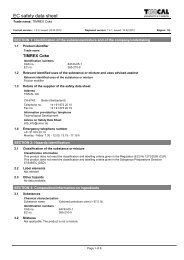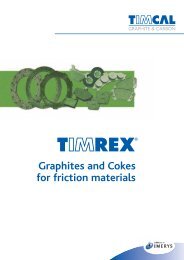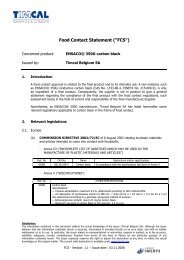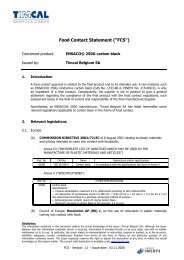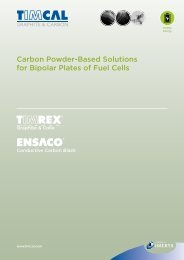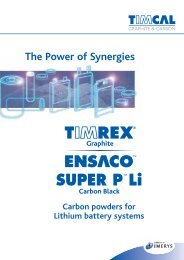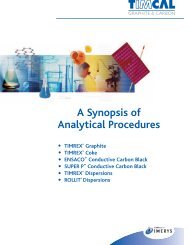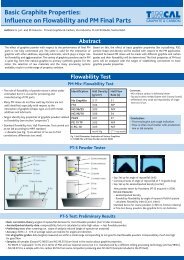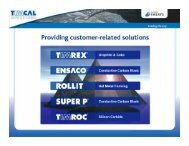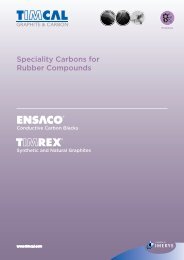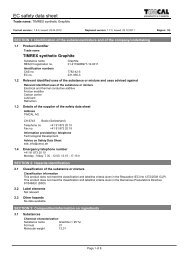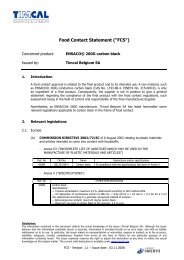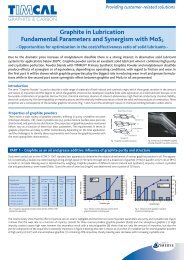ENSACO® Conductive Carbon Black for polymer ... - Timcal Graphite
ENSACO® Conductive Carbon Black for polymer ... - Timcal Graphite
ENSACO® Conductive Carbon Black for polymer ... - Timcal Graphite
Create successful ePaper yourself
Turn your PDF publications into a flip-book with our unique Google optimized e-Paper software.
10<br />
The selection of a<br />
conductive carbon black<br />
NENSACO ® <strong>Conductive</strong> <strong>Carbon</strong> <strong>Black</strong>s find<br />
their applications in an unlimited number of<br />
plastics. The combination of the <strong>polymer</strong> type<br />
and grade and the carbon black grade are determining<br />
the overall electrical and mechanical<br />
per<strong>for</strong>mance.<br />
NThe main parameter influencing the final<br />
conductivity of a finished part in a given <strong>polymer</strong><br />
is the type and level of carbon black used.<br />
NThe higher the structure of the carbon black,<br />
the lower the level of carbon black needed to<br />
achieve the required conductivity. Nevertheless,<br />
in a minor way, other parameters like the additives<br />
in presence, the compounding or processing<br />
conditions may also influence the final conductivity<br />
of parts.<br />
NLow surface area conductive carbon blacks<br />
show a particular advantage on dispersion and<br />
processing.<br />
NPercolation curves – correlating the volume<br />
resistivity and the carbon black percentage – are<br />
a useful comparative tool to predict the conductivity<br />
in place and to select the more appropriate<br />
system. These curves are valid <strong>for</strong> a given <strong>for</strong>mulation<br />
and sample preparation technique.<br />
NThe selection of the conductive carbon black<br />
will also influence:<br />
the compounding behaviour<br />
(dispersibility, resistance to shear, mixing cycle,<br />
melt flow index, extrusion throughput);<br />
the surface appearance of the finished<br />
material (number of surface defects);<br />
the mechanical properties<br />
(<strong>polymer</strong> property retention, rein<strong>for</strong>cement);<br />
the overall price – per<strong>for</strong>mance ratio.<br />
www.timcal.com<br />
Typical applications <strong>for</strong> ENSACO ® <strong>Conductive</strong> <strong>Carbon</strong> <strong>Black</strong><br />
Electrically<br />
conductive plastics<br />
The preparation of a<br />
conductive compound<br />
NSuitable mixing equipments <strong>for</strong> the preparation<br />
of black conductive compounds include<br />
internal mixers, twin screw extruders, single<br />
screw kneader machines and LCM. The feeding<br />
of low bulk density, soft flake-type carbon<br />
blacks into extruders requires the use of twin<br />
screw feeders and separate introduction on an<br />
already molten <strong>polymer</strong> (split feeding technology).<br />
Some typical final plastics<br />
applications:<br />
handling of electronic components:<br />
carrier boxes, carrier trays, carrier tapes, etc.;<br />
films: antistatic and conductive films,<br />
packaging films, garbage bags, etc.;<br />
automotive industry: fuel injection systems,<br />
anticorrosion systems, fuel tank inlet,<br />
electrostatically paintable parts, etc.;<br />
transport: mobile phone parts, wheels,<br />
containers, bins, pallets, etc.;<br />
computer: antistatic articles <strong>for</strong> computer<br />
& accessories, CD player, etc.;<br />
health: medical applications,<br />
cleanroom equipments, articles <strong>for</strong><br />
antistatic workplaces, etc.;<br />
antistatic flooring;<br />
heating element;<br />
sensors;<br />
PTC switches;<br />
UV protection and pigmentation.<br />
In the following pages there are some of the<br />
results of experimental work carried out on<br />
ENSACO ® <strong>Conductive</strong> <strong>Carbon</strong> <strong>Black</strong>s in different<br />
<strong>polymer</strong> compounds.<br />
The data shown here are given as orientation<br />
and are valid <strong>for</strong> the particular <strong>for</strong>mulations<br />
and sample preparation technique<br />
mentioned. Results in other <strong>polymer</strong>s, full<br />
studies and publications are available upon<br />
request.



